The World Series of Punts.
The very first hand here, we altered the spot a little bit. We have the button open raising instead of the hijack (or was it lowjack?). I find these spots very interesting.
I see a lot of you guys struggling in these spots when they play against other big stacks and we have Jonathan Little in the small blind. So at the end of the day, for postflop, it's going to be between Jonathan Little's straight flush versus the big blind who calls down in my opinion and doesn't really play his hand really well.
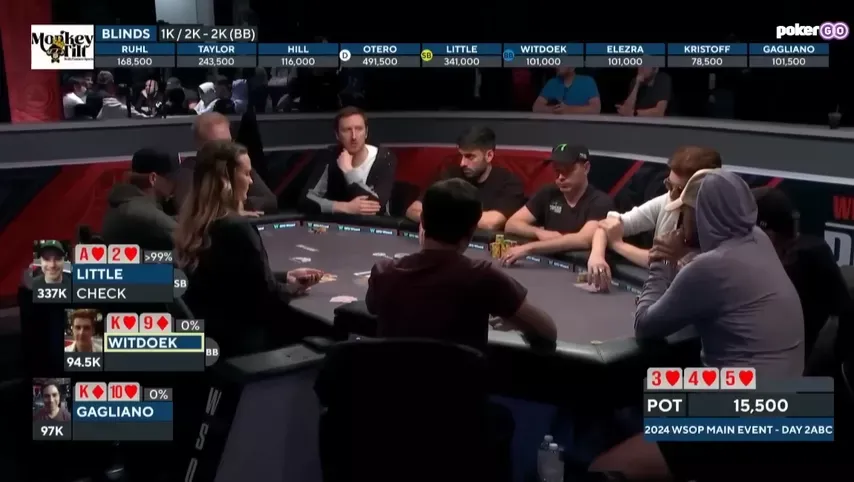
So the button here in our scenario. Again, it's not the real scenario from the WSOP, but I found the spot a lot more interesting for small blind versus button dynamics. We had it last year with Chance Kornuth against Rigby. Chance Kornuth, on a podcast, talked about how he did not like his stack-off with and some of it can be avoided with 3-betting less or playing a little bit more lower variance.
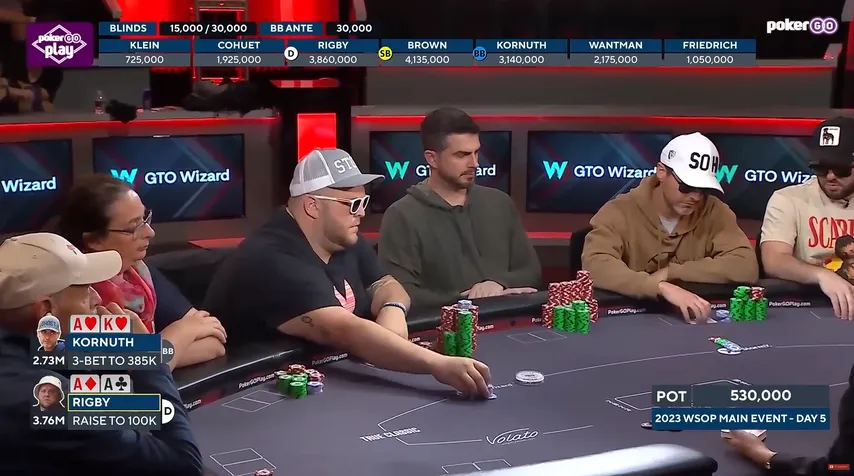
And here in this scenario, we see Jonathan even flats a little bit of Ace-King off, flats Kings. So the EV flatting versus 3-betting is completely identical, but in order to avoid a massive setup here, it's not terrible to flat hands you're supposed to be 3-betting.
If you want to play it smart, you're playing a very soft tournament, the WSOP Main Event, you play against a bunch of fishes and then you have the button who has a much bigger stack than you or similar stack who can inflict a lot of damage on you – Do you really want to play a 40, 50, 100 big blind pot out of position with Aces?
So here grinding the table, keeping the variance low, playing a lot of small pots and then sometimes waking up with unexpected hands and you see even the solver understands it with a little bit of ICM consideration. We ran it here 75% of the field are left, there is a little bit of ICM and you can see it suggests you to sometimes flat.
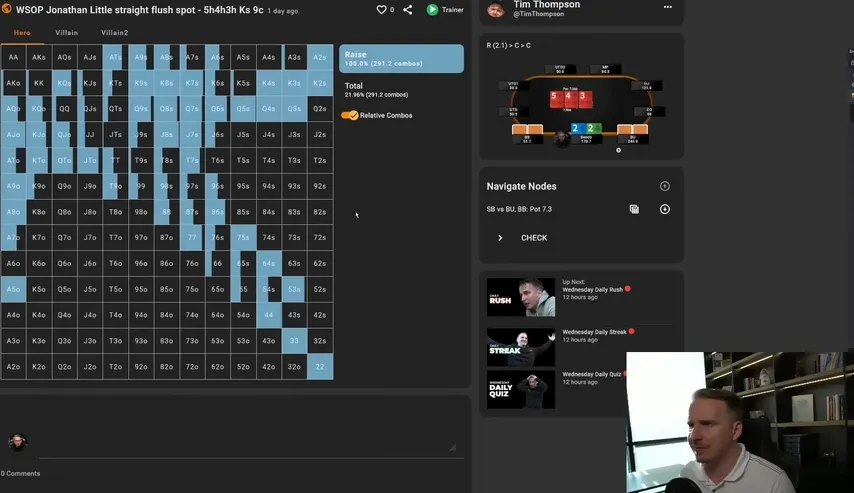
That's totally cool. So you can see here depending on your style, depending on how you perceive the table, your image, it's totally reasonable to flat.
All right, for the small blind obviously, Jonathan wants to check here his range on this board and then the big blind decides to lead, which I don't think is a terrible play, but we had to force him to give some leads. Because, in GTO, technically he shouldn't have any leads, which in my opinion makes a lot of sense. Yes, from the big blind he has hit this board really well but we have a small blind flatting range, we have an open raising range and they're going to have a decent amount of flushes on this board as well and also you're going to be having whiffed very often here with your Queen-8 off, Queen-7 off.
The Flop:
This a pretty interesting board. He [Jonathan] decides to lead. So we gave a little bit of leading here with like all sorts of hands. As you remember he was leading the King-Nine off here which isn't terrible. I don't think it's a big mistake, but yeah.

Now it gets interesting. The open raiser gets out of the way with a fold and then Jonathan decides to raise.
What is Jonathan's GTO strategy supposed to be against the leading range? So obviously he's raising the here as we can see almost full frequency, he wants to get the money in. There are some hands where in my opinion, you can play GTO in a WSOP Main Event. But, if we look at what the solver wants to raise, I don't think against the big blind leading range, that Jonathan (who is a very solid player) is going to start raising all these hands that a solver is supposed to raise.
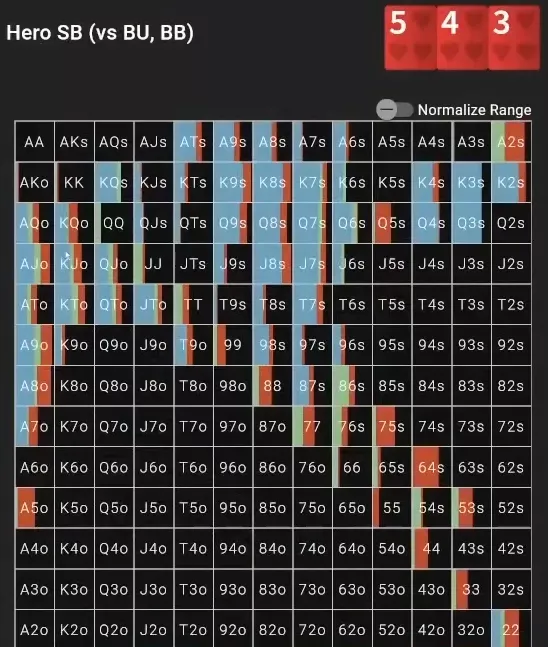
All right, so we see here Queen-Ten off, Jack-Nine off, Ten-Nine off. All of these kind of hands, Jonathan might not even have in his flatting range in the first place, no matter against the button who has a big stack. He might fold those. Also in the real scenario here the hijack or lowjack was open-raising, so Jonathan probably is not going to have those hands right? And, if we eradicate Jack-Nine off, Queen-Ten off, Ten-Nine off, maybe King-Ten off ahead against King-Nine off anyway, which bluffs are left?
It's going to be a bunch of flush draws like here. He's going to be flatting a lot of these suited hands more often than these offsuit hands, even those semi-bluffs Ace-Five off, Ace-Eight off.
Ah, you're behind against those anyway, right? So why the f*** here [are we] being sticky with the King-Nine off, it doesn't make a lot of sense.
The Turn:
All right, however, you call an 8-9 big blind raise. It's still still not the end of the world. You can still get out of the way later on. Let's keep looking. So the call comes and the turn is a .
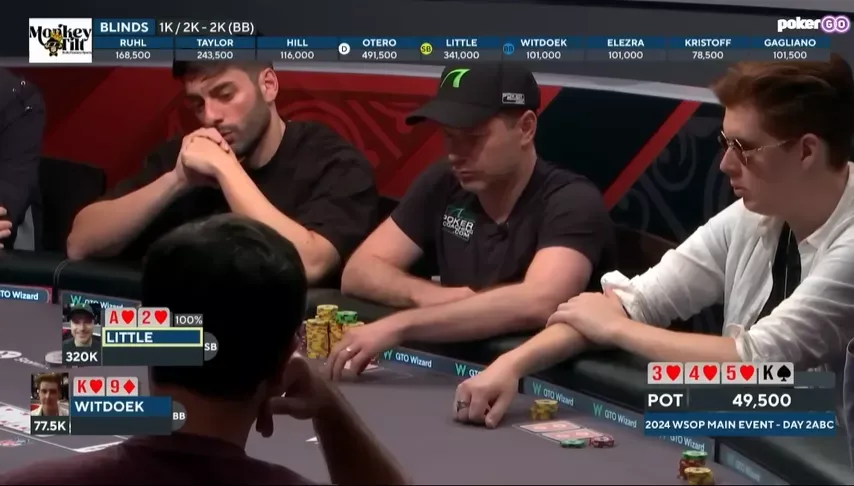
Now small blind, Jonathan, does everything right, right? He got the cookies, you're just going to keep betting. What are Jonathan's bluffs going to be? Obviously we see here the Jack-Nine off is supposed to continue. So even if Jonathan has those Queen-Ten, Jack-Ten off kind of hands, he might not continue every single time because once your opponent calls, you usually going to be putting him on a very strong hand.
So this is these are the GTO stuff if you want to solve it and play this strategy in a WSOP Main Event or soft online MTTs – again, you're making pennies. This is what you need to understand. So, these plays are very unrealistic and something you should never strive to do. So you're going to decide do you want to play solver-approved or do you want to play a realistic approved strategy?
This is just a punt call.
The River:
Now, on the river, we see the and we see that if Jonathan gets there with Queen-Ten, Queen-Jack off, Jack-Ten off, those are supposed to bluff.
I think most good tournament poker players choose this approach over this super aggressive GTO strategy approach where it's super high variance, you don't really know how your opponent is responding against. We see that here, another guy who can't fold King-Nine high on the flop. So in my opinion, most smart tournament poker players wouldn't be that aggressive here with Ace-Jack, Ace-Ten high when they know they have such a big edge. You can see when the pot gets big, they usually have it and they punish those players who have a hard time folding.
Listen, I'm not perfect either. I've been doing stupid call-downs in spots where it's absolutely unnecessary, so I can see how it's possible to level yourself, but obviously want to learn together and improve.
And if you listen carefully to the commentary [from Witdoek], "Well, I guess you could be value betting worse"
No, you don't [beat value hands]. Jonathan is very well aware that big blind can have so many flushes. You would never jam a Four-Five suited or what, like King-Three or King-Five. You're never beating value, period. So that's the typical justification, trying to find fantasy reasons to justify bulls*** plays.
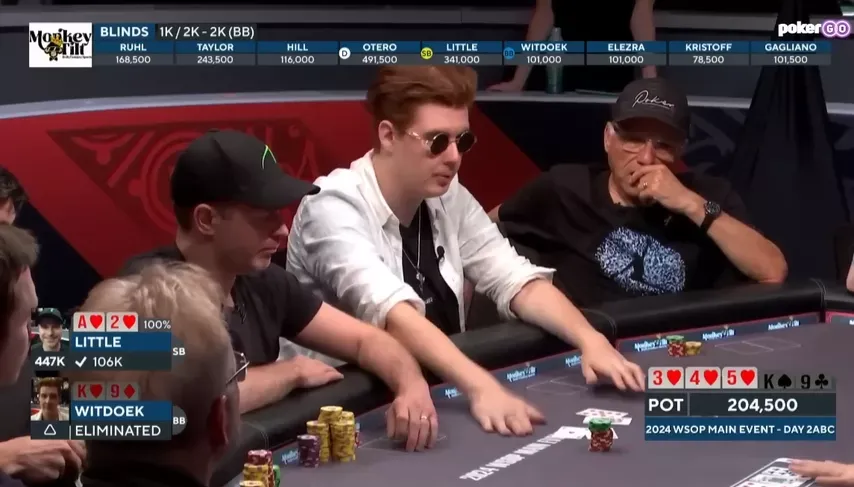
Again, not meant to s*** on the player here. I s*** on our own limitations because I've been doing it myself and I don't want you to do the same. Observe your bulls*** and be realistic. Okay, once in a blue moon maybe Jonathan has a read and he decides to value jam Four-Five suited, but do you really want to rely on that one or two combos that you might have versus those 10, 20 combos of flushes? Plus, if he goes for a thin value jam with a set, you're owning yourself and you're trying to hold on a straw, right?
And this happens to all of us and it's very important to observe that and get rid of those very stupid limitations and weird beliefs we have sometimes in these spots just because we're really curious and we kind of like, "Oh we have two pair," and we kind of find justifications to justify that call. But let's be honest, no, not going to happen here. Surely, Jonathan can have some bluffs, but again it doesn't justify calling it down.
If we assume those bluffs, right, obviously then in GTO Wonderland we're going to be calling this. If we look at the King-Nine off here, we see it's a call that he gets to river with, but yeah, not really going to happen. So this is just a clear fold if we consider edge and future game.
I think from all of these hands, I would say that's the biggest punt. The other ones I don't actually think they're such a big of a punt and we get right into it.
Kristen Foxen vs Joe Serock
I'm never a big fan of crazy hero calls for your tournament life because you're very much relying on having the better hand. If you 5-bet jam all-in, if you bluff jam, you always have a little bit of equity so you can still win the hand and you have the fold equity.
If you call an all-in on the river, you never have fold equity, right? So you want to be on point. That's why hero calling is so dangerous, probably one of the most overplayed spots where people think they're good and they understand GTO, but it's costing you a lot of money because you never have the fold equity.
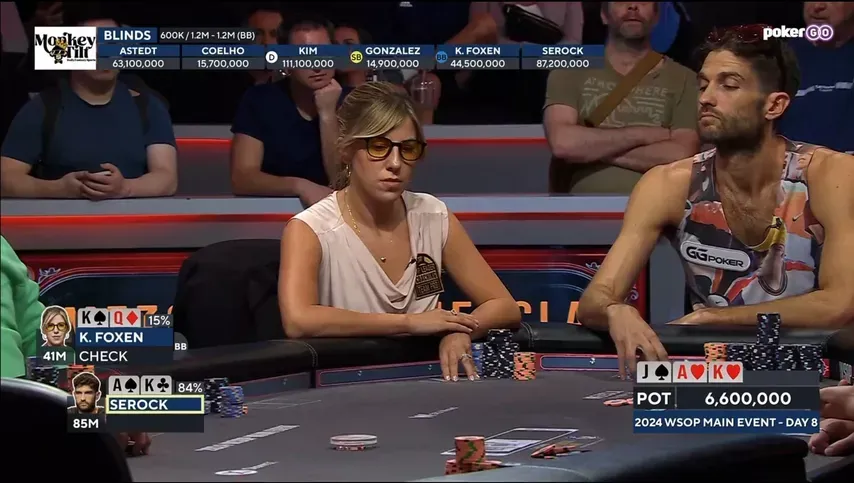
All right, let's get into the next spot, the King-Queen off, and here we need to consider two scenarios.
Obviously, the first one is just the pure GTO solution with ICM. It's not just chip EV, everything adjusted for that ICM scenario. That's what I also shared in my Twitter thoughts on this hand, I don't think it's that bad.
"All the people saying Kristen Foxen's turn shove is a punt, probably never node-locked a sim."
Bencb on Twitter
In my experience, I've been running deep in those WSOP online events, GGPoker, PokerStars SCOOP Main Events, they're very similar where there's a lot of money at stake. There's like a million, two million, three million for first. It's not the WSOP Main Event, I get it, I'm not a live pro, but I would consider I have a lot of experience being in those extremely high-pressure moments and playing against regulars who are very aggressive and trying to bully those smaller medium stacks.
The Turn:
I'm going to skip it here to the turn where it's going to be the most critical scenario. All right, so if we look at the hands that villain is betting here, , we see betting quite a lot, but also in this scenario, right? WSOP, why would you bet here?
You're short on value, you have a monster big hand, I get it. But, there's a high chance we face a check-jam still, right? So we want to realize our equity. I don't think it's happening that often.
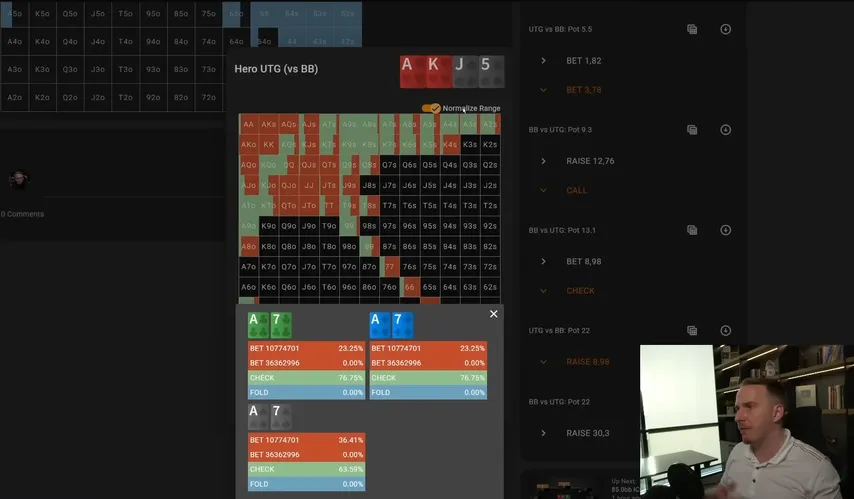
I think he cannot expect Krissy [Kristen Foxen] to go for such a big play here, right? So we would assume that mostly going to be calling.
Maybe she jams or on the turn, but most of the time you want to just check it back Ace-Seven of Spades, see a river, and then take it from there. Chrissy can still bluff the river with a hand, so the betting range on the turn is going to be hands like , . When you face a jam, you have an easy fold. You might be up against some combo draws, but most of the time it's going to be , , or or like two pairs, set straights, right, and maybe some combo draws.
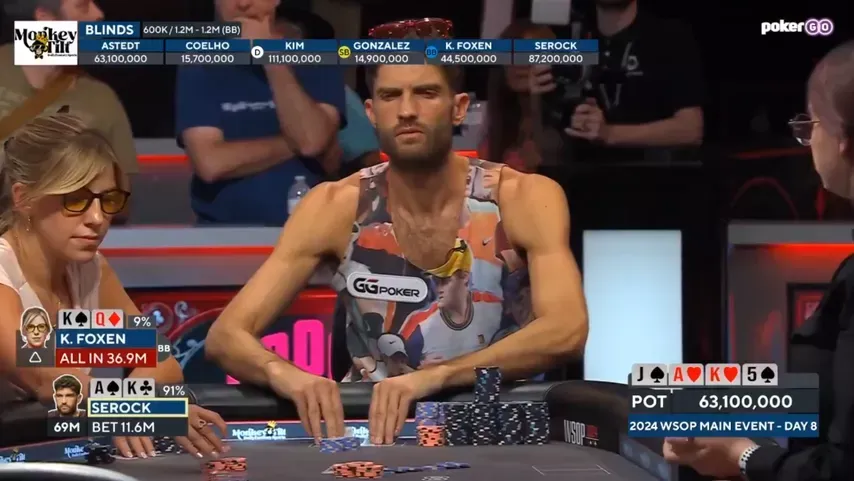
So that's why you don't mind betting here. You get to fold most of the time against normal opponents. You get to fold, , which still has a lot of equity. You also might fold out the chop already. I mean, what are you there like WSOP Main Event, you got , you're like, "Fuck it." Do you want to risk it all now or risk a big chunk of my stack? So there's a good chance we force folds.
So I think that's a very natural strategy for a lot of good players here to do on the turn and then additionally apply pressure with your random bluffs. The opponent is still going to have lots of check-folds on the turn, has a big stack, he doesn't mind applying pressure here. And we see that the solver wants to check back , quite often here, which I don't think is necessarily the case. , are checking back very often. In my opinion, way too often. I think most regs would just auto-bet the turn and keep barreling with the gutter here.
And then we see that starts shoving in. She's all-in. We see that here, the solver wants to bluff jam off, which I think it's still marginal.
I get it, but I would never consider this a punt.
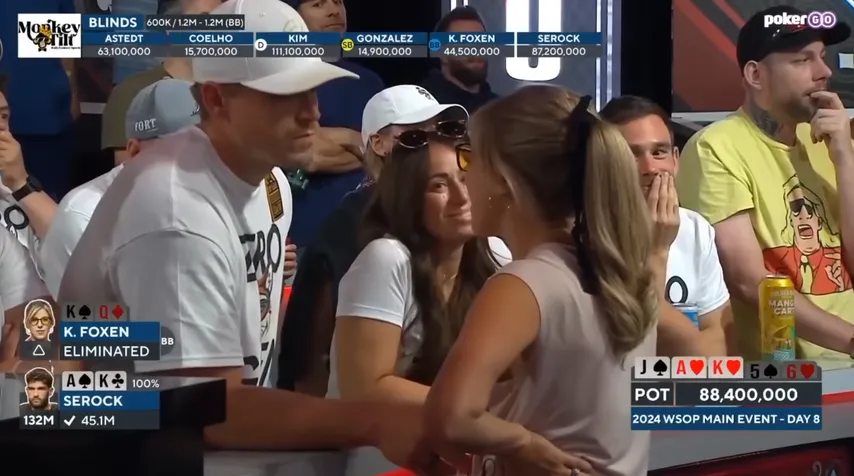
I've seen some analysis where they break it down to it's losing a big blind or two. I think she's not losing a big blind or two here on realistic assumptions. If we make a little more favorable, I think she's going to win three to five big blinds on average here if the UTG player is betting more of the kind of hands.
Brian Kim vs Boris Angelov
So Angelov opens the button, 3-bets from the small blind, and Lena 4-bets.
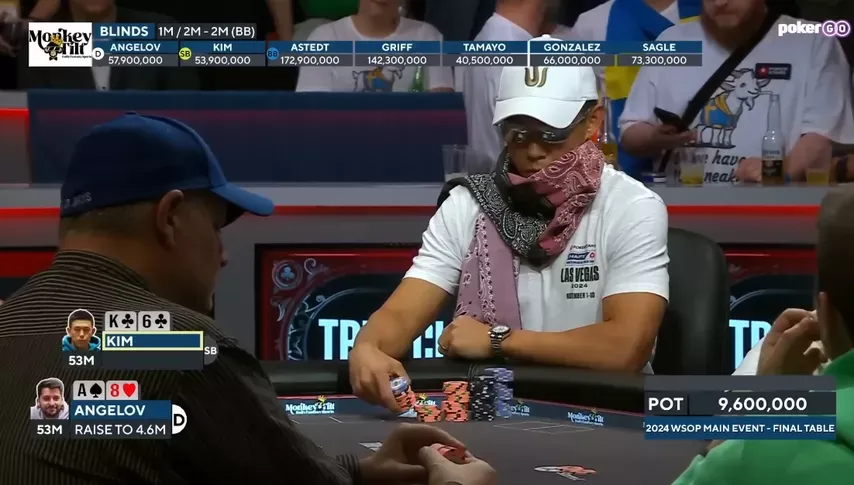
Small blind sends it all in. Is it a punt or is it not a punt?
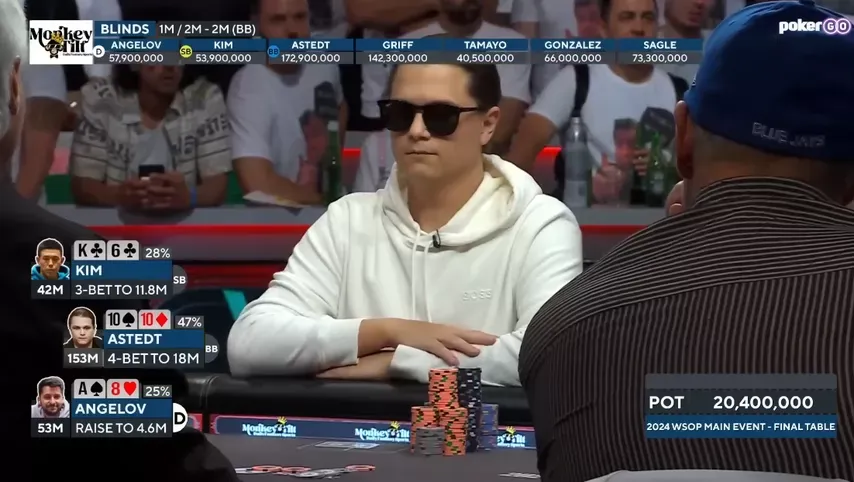
A punt is not the hand you're going all in with, it's the profitability. Sometimes bluffing with Seven-Deuce off might look like a punt, but if it generates you profit in the long term, it's not a punt. If it goes wrong, it looks stupid, it looks like a punt. So that's the question.
Obviously, here we also had to not lock because technically King-Six shouldn't be 3-betting in the first place.
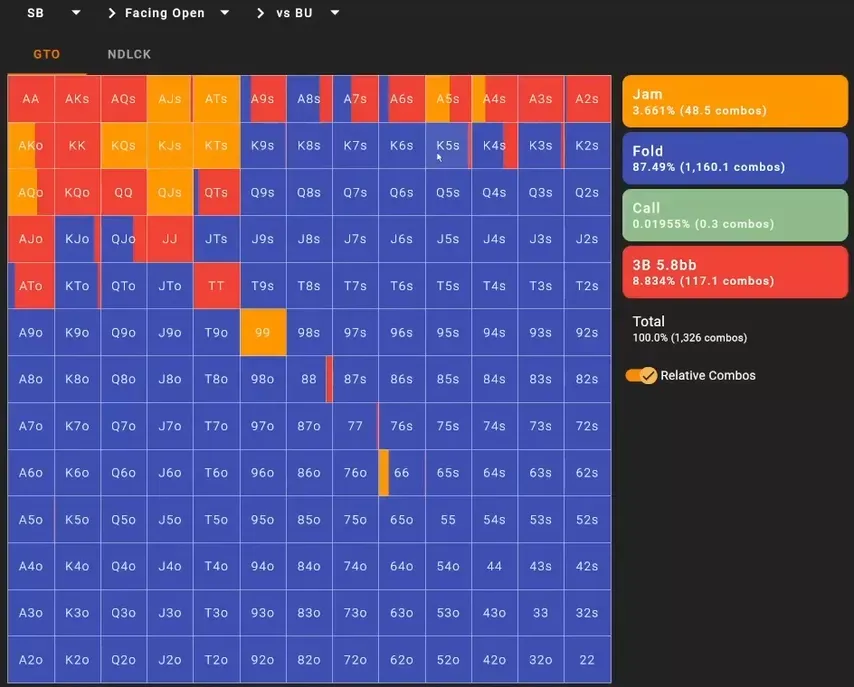
All right, that's the 3-betting range. So we had to not lock this and have him 3-betting some of the King-X to see what's the response supposed to be.
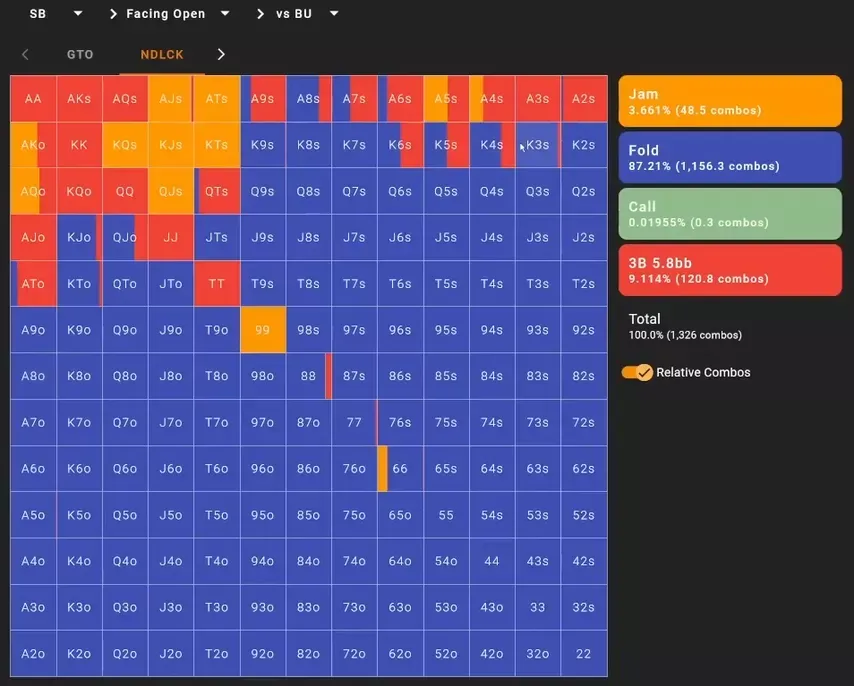
And here it's a lot more circumstantial, the way Lena plays, the way the average player plays. I mean, I get it, I've seen some opinions. Lena has been playing rather solid, but I can also tell you from my own experience, the Swedes really can amp up the aggression if they feel someone is not having the right frequencies. So also the sample size is not big, the spots are a little bit different. Just because he has been showing solid hands, doesn't mean his pro player profile, in general, would aim more toward Lena not 4-betting enough.
Yeah, I can tell you the way he approaches sometimes final tables, yeah, that's tough to say. He can definitely wake up with a few more bluff 4-bets than you think. He can also just have it there almost all of the time if he thinks, you know, "This final table is so soft, I don't want to bet around."
So let's have a look here. King-Six suited, what we assumed is also for the big blind this kind of range.
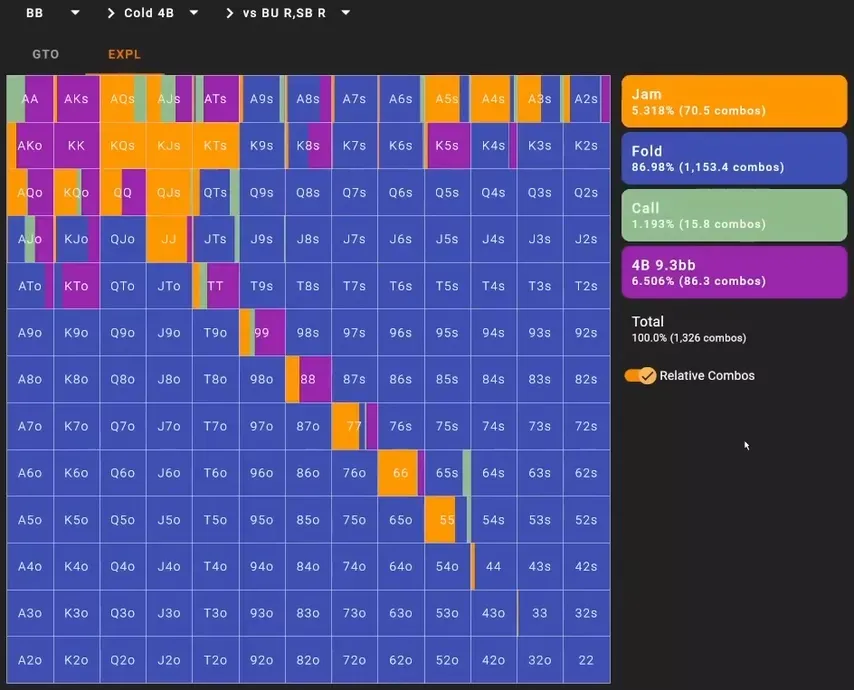
Again, we had to alter it a bit because King suited, we're not in the GTO environment anymore, we're here on the streets. So we have to make assumptions to see, and I think it's a very realistic cold 4-bet strategy. Could be some suited King-X, a little bit of suited Aces, and I think also here you see that's what Lena is supposed to do. Actually, lots of shoving, very unrealistic, don't think it's going to happen. It's not what Lena's going to do.
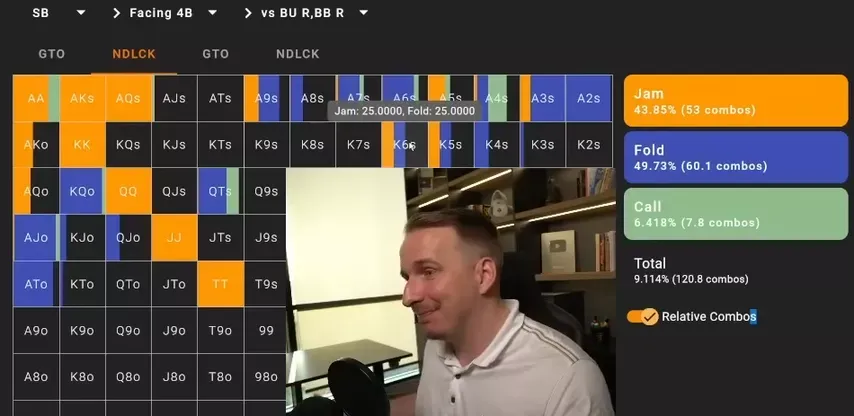
I think most regs wouldn't be shoving those hands ever. They would either small 4-bet small like Queen-Jack, King-Jack, King-Queen suited. You have Aces, right? Bluff to choose from, that's usually a more realistic strategy. So it's like 6.5%, something like this. Tens plus, I think also Jacks is probably going to be 4-betting small, Queens, and against this strategy, let's have a look.
King-Six suited is okay to 5-bet jam. It's not a punt.
Yes, it's very marginal, it's probably just making you a quarter of a big blind or tenth of a big blind profit because otherwise it wouldn't be a frequency play. It's slightly above profitability here.
So the question is, does Lena 4-bet bluff more, 4-bet bluff less? Who the fuck knows, right? So I would, if I see it, I would probably not be so happy with the jam. I mean, I'm happy because King-Six is such a powerhouse and such a great hand to jam, and you guys know we had some fun with that hand on stream sometimes.

But what you need to understand is that I do believe that Lena will have more 4-bet bluffs that he's supposed to jam.
So King-Queen, King-Jack suited, he's probably going to be bluffing those. I don't think he's going to be 4-betting and then calling off with Nines to Eights. I think Tens is the bottom because he started tanking. But ultimately he was pot committed and that's why he flicked in the call.
But if he doesn't have Ace-Queen, Tens, if he has anything worse, if he has Ace-Jack suited, Ace-Ten suited, you see also those hands are supposed to call. So against that shoving range, we see Ace, these hands are supposed to call here. Ace suited, Ace-Jack off, Ace-Jack off is folding, but Ace-Queen off, I think if Lena 4-bets Nines or Ace-Ten, he's always folding. Same for Ace-Jack suited, he's going to be stacking off Ace-Queen, Tens plus, and then obviously the bluffs are folding.
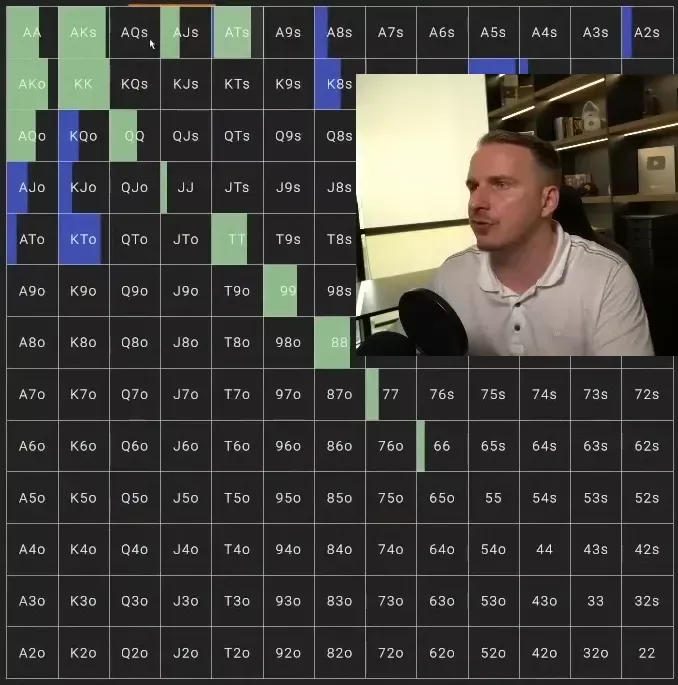
So I think here, there's a good chance that this spot from Kim, this jam (in the long run) is going to be very profitable.
Bencb Ranks the WSOP "Punts"
All right, so if I would do a ranking, the King-Queen bluff is my favorite. I think it's going to generate the most profit assuming more realistic ranges.
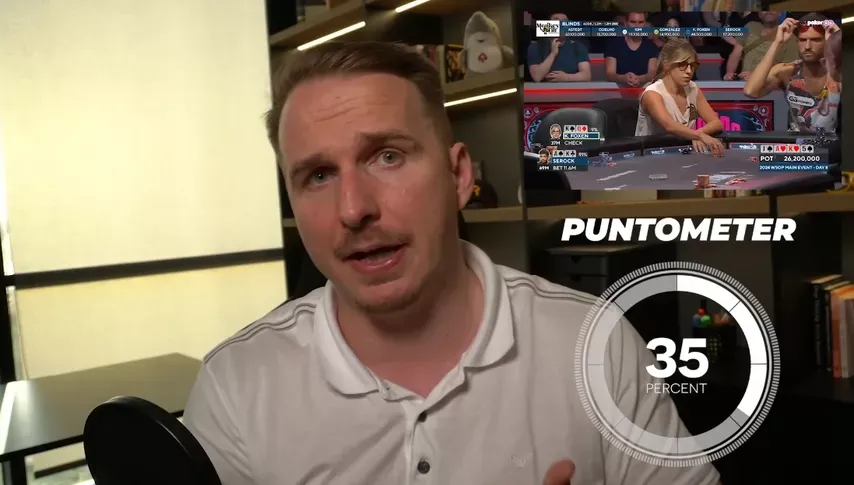
The 5-bet jam from is the second most profitable spot.
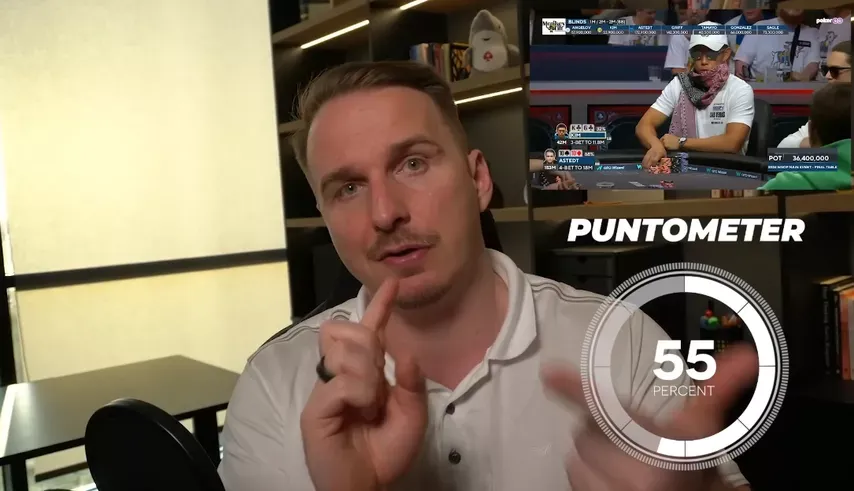
The hero call on the river, I think is a big punt.
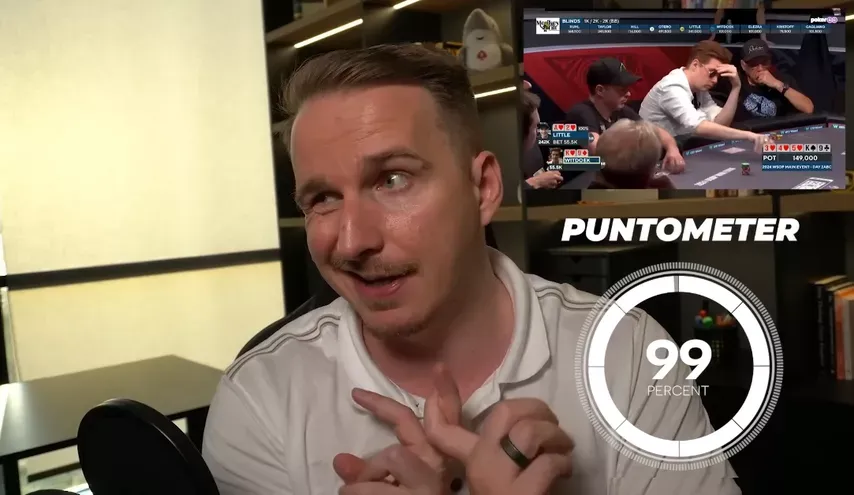
The Professional Approach to These "Punts"
Now you might wonder about Ben, it's a WSOP, right? So you need to differentiate the thinking between a pro and an amateur. We don't care that this is a very specific event. We think about the long term because what if the jam goes through and you win a lot of chips and it helps you to become one of the bigger stacks? Right, this is what you neglect. It's not like you do this play and you lose every single time.
It's a game of long multiple millions of decisions. Every single hand, bet, raise, fold, and you want to do as many as possible.
The problem with amateurs and beginners, and I get it, I understand some of you just want to consume it for fun and you want to play, you don't have these ambitions to become a pro. But if you really want to make money serious, if you want to win money in poker long term, you need to refrain, you need to drop this kind of like, "Oh this one big event." Then you're playing outside of your bankroll management, you don't understand long-term profitability in poker and you don't understand variance. This is not how we pros think.
That's why you see the same pros on these big final tables. Maybe not the WSOP main event, but the Triton Events, online high rollers, online events. You see the same faces and a lot of the players now being around for 10 years and still making money with poker because they understand.
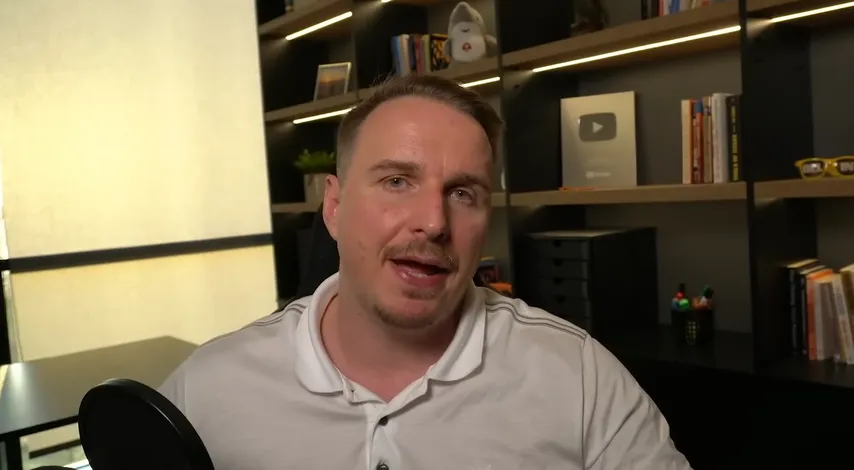
If it's profitable, if it's somewhere reaching a threshold where I say yes, it's worth risking my tournament life, it's profitable enough for me considering my edge and ICM. And these numbers are not measurable, it's a lot of experience, it's a lot of muscle memory, it's a lot of reviewing, looking at the numbers, looking at the strategies, analyzing the strategies. Does it make sense? Did I bulls*** myself? Did I come up with some just fantasy reasons to justify my bulls*** plays? All these things and you never know, there's no guarantee.
So what we do is make decisions based on our experience and I'm pretty sure that Chrissy did a decision based on how she perceives most opponents playing in these final table spots. They love to be way too aggressive, betting a lot and then folding too much, and that's why she went for this play. I have a lot of respect for that. I think it's a good play. People just saying, "It's a punt, she punted off!", sorry, they don't understand poker. They've never run a sim, they've never even... maybe they are jerking off to their GTO Eizard, pulling a fold, right? And then even running a chip EV range and whatnot and never really altered the range, never really made an exploitative or not locked sim, trying to make it more realistic because they lack the experience.
It's totally cool, we can disagree, but let's be real, some of them don't really have any idea how poker works. I have a lot of respect for those plays. I think there's a lot to learn from the mighty boy spot earlier to not make these call downs and sometimes taking a few more risks, but you need to study, you need to prepare for those spots.




















